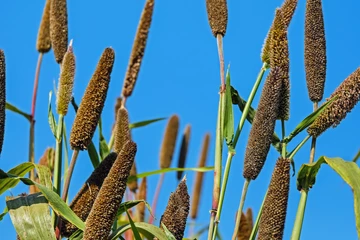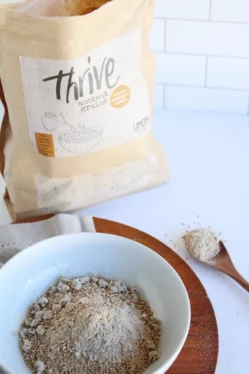- Your cart is empty
- Continue shopping
Millet – a ancient grain that shaped society as we know it
-
Umoya Foods
- Posted on
- Categories:Blog
- 0 comments

Thinking about the meaning of existence, how we came to be, where we are in the universe, and our impact on earths unknown eternal future are quite heavy contemplations… Now imagine if you were an ancient cereal grain like millet that:
- Played a part in settling hunter-gatherers to initiate societal structures we know today,
- sustained the earliest known civilisation (Sumerian) as they invented the first written language,
- and observed three agricultural revolutions!
A little grass that has gone through millennia of natural adaptation to harsh environments and refinement of quality nutritional composition, only to end up in the 21st century being thought of as a bit of a primitive “poor-mans” food…
If I put myself in millets shoes I would definitely be experiencing some next level Melvin nihilism (the robot from Hitchhikers guide to the Galaxy that has “the brain the size of the planet” and no chance to use it).
Millet is a gluten free, protein and micronutrient dense grain that has a short seed to harvest timeline while being a climate appropriate and drought resistant crop! Issue is millet isn’t being used to its full potential to combat the massive food system challenges we currently face! So it’s time to throw a little love millets way and embrace it into our every day!
 Millets introduction to humanity has taken on mythological status in China with Hou Ji (Lord Millet and an actual figure in Xia Dynasty history) being credited as bringing millet down from the heavens. Traces of the first domesticated millet in Northern China date back 10,300–8,700 years ago and its journey through the Neolithic period garnered it features in the Old Testaments’ bread recipes (Ezekiel 4:9) and a spot in the gardens of Babylon!
Millets introduction to humanity has taken on mythological status in China with Hou Ji (Lord Millet and an actual figure in Xia Dynasty history) being credited as bringing millet down from the heavens. Traces of the first domesticated millet in Northern China date back 10,300–8,700 years ago and its journey through the Neolithic period garnered it features in the Old Testaments’ bread recipes (Ezekiel 4:9) and a spot in the gardens of Babylon!
The cultural significance of millet is no surprise considering its long career. You can find mentions of millet in Macedonian folklore where it is scattered on the graves of impaled bodies suspected to be vampires in order to distract the corpse with clean-up duty should they rise. And today, in a dedicated festival celebrated by the Yimchunger Nagas of Nagaland in North East India, millet harvests are celebrated and God is thanked for the support! This deep-rooted presence in many traditions and mythology has contributed to its longevity, however when you consider its growth efficiency and nutritional quality; its production decline is hard to understand.
 Millet accounted for 40% of the global supply of cultivated grains before the Green Revolution (1950s to late 1960’s) after which it dropped down to 20% while rice production doubled and wheat production tripled! Increased dependence on processing aids and technology to increase yields also accompanied this which affected farmer activities across many fields and resulted in both the accessibility of millet compared to other major cereals and viability of farming millet to sustain livelihoods to decrease.
Millet accounted for 40% of the global supply of cultivated grains before the Green Revolution (1950s to late 1960’s) after which it dropped down to 20% while rice production doubled and wheat production tripled! Increased dependence on processing aids and technology to increase yields also accompanied this which affected farmer activities across many fields and resulted in both the accessibility of millet compared to other major cereals and viability of farming millet to sustain livelihoods to decrease.
However! Millet is having resurgence as its sustainable, affordable and simple farming requirements are being recognised as valuable traits in a time of immense food and socioeconomic insecurity! Finger millet has even been named one of Knorr and WWF-UK’s Future 50 Foods to support the creation of a sustainable food system and the United Nations has deemed 2023 as the International Year of Millets!
The nourishing quality of millet is no secret and adds to its Future 50 Foods motivation. While there are actually a host of millet varieties within the family some common nutritional characteristics across the board are:
- High quality minerals and vitamins including magnesium, Niacin (Vitamin B3), Thiamine (vitamin B1) , phosphorous
- Powerful antioxidants
- A great source of fibre
- Protein dense with all essential amino acids bar lysine and threonine.
These nutritional benefits are complemented by studies done which connect millet with other potential health benefits including combatting cancer and cardiovascular diseases, lowering blood pressure, cholesterol and helping manage diabetes.
 Umoya Foods Thrive Ancient grains is an instant cereal that makes millet accessible. We have used Pearl Millet which has been traced back to 4500 BP (roughly 2500 BCE) Mali and was domesticated in the semi-arid Sahel region. Like the rest of its family Pearl Millet is a crop resilient to climate change and suited to growing in acidic or salty soil that is not kind to a number of modern cereals and grains. It is also hardy against pests and disease which mean that the farming thereof requires relatively few inputs. All of this is naturally ideal for rural agriculture and small-scale farmers! In a world where earning a living is harder than ever and rural livelihoods are under immense pressure, the amplification of millets potential impact on alleviating economic stress must not be overlooked!
Umoya Foods Thrive Ancient grains is an instant cereal that makes millet accessible. We have used Pearl Millet which has been traced back to 4500 BP (roughly 2500 BCE) Mali and was domesticated in the semi-arid Sahel region. Like the rest of its family Pearl Millet is a crop resilient to climate change and suited to growing in acidic or salty soil that is not kind to a number of modern cereals and grains. It is also hardy against pests and disease which mean that the farming thereof requires relatively few inputs. All of this is naturally ideal for rural agriculture and small-scale farmers! In a world where earning a living is harder than ever and rural livelihoods are under immense pressure, the amplification of millets potential impact on alleviating economic stress must not be overlooked!
So it’s pretty clear that millet should be celebrated the way it once was! After all, without millet who know how civilisations would have formed… we could all be Douglas Adams’ Bartledannians having “no desires, dreams or hopes”. Now that would be a sorry state.
Anissa Davel
Food Scientist
